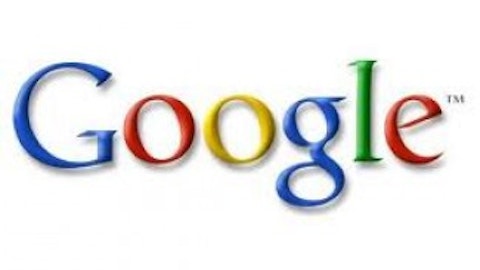
Many thought that the earnings call for the second quarter reported on July 18 would be the turning point. Google did present weak results (its operating income fell by approximately 4% to $3.12 billion) and the stock price did fall by as much as 4%.
However, by now the negative momentum caused by the weak earnings call has almost disappeared. Overall, in the past five days, the stock price decreased only 2.9%, which suggests that Google Inc (NASDAQ:GOOG) is still far away from the danger zone, unlike Apple Inc. (NASDAQ:AAPL).
That being said, I think the latest earnings call provides us an opportunity to review Google’s competitive advantages, main competitors, risks and opportunities. Is Google still a buy after July 18? This article summarizes my findings. Before answering the above question, let’s start with a brief overview of the latest earnings call.
Google’s latest earnings call: The good, the bad and the ugly
First, let’s start with the good news. Consolidated revenues came out at $14.11 billion, which represents a 19% year-over-year increase. Even better, core revenues (which exclude Motorola) grew 20% over last year. The bad news: although sales (excluding costs of payments to partners for traffic) came out at $11.10 billion, this was not enough to beat the street consensus of $11.38 billion, according to FactSet. The ugly part? Operating income fell 4%, to $3.12 billion. This happened mainly because the average cost per click (CPC) is falling as mobile traffic increases.
CPC for mobile ads is much lower compared to that of clicks coming from PCs. And since traffic from mobile devices is increasing, the overall cost per click had to go down. It fell by 6%,

Now, can Google Inc (NASDAQ:GOOG) minimize the cost difference between clicks from PCs and clicks from mobile devices? I believe it can. Unlike Apple (which may not be able to stop the increasing popularity of Android-based Samsung devices in emerging economies), Google may have more tools and choices to control its biggest problem: mobile monetization.
Below some concrete measures Google is about to take. Starting on July 22, advertisers using Google Inc (NASDAQ:GOOG) will be able to choose not to buy cell-phone ads, but will be required to buy tablet ads instead. This is the new AdWords program and it should help to, at least, limit the decline in overall cost per clicks.
There’s also the near release of the Moto X smartphone model, expected to go on sale this summer. If this launch is successful, it could steal significant market share from Apple Inc. (NASDAQ:AAPL) and Samsung in the smartphone business, and create a new cash cow for Google. The official presentation of the Moto X is Aug. 1 in New York, so stay tuned. At any rate, regardless of whether the Moto X is a success or not, the Android platform will continue to lead as the most popular mobile OS, and eventually this could help Google Inc (NASDAQ:GOOG) to increase the number of paid clicks, because mobile traffic could increase so much that it will eventually offset the negative effect of relatively cheaper mobile clicks.

But, is Google a buy?
From a long-term investment perspective, nothing has changed. There’s an explanation for the low income figures. First, mobile monetization remains weak, but Google’s already taking some measures. R&D spending is on the rise, as it grew to 14% in the second quarter of 2013, up from 13% reported in the prior year. Also keep in mind that Google Inc (NASDAQ:GOOG) is constantly launching new products and projects (some of them very promising, like Google Glass and Google Ioon). In the short run, this hurts profit margins, but in the long run, these new projects put Google in a closer position to finding the “next big thing,” just like it did when it chose to develop Android or when it bought YouTube.
That being said, always keep in mind that Google has one of the highest P/E ratios in the industry at 27. Therefore, Google Inc (NASDAQ:GOOG) is by no means a cheap stock and will have to deal with high expectations on a regular basis. This makes the stock very vulnerable to short-term negative deviations, when the company fails to beat the street consensus, like we saw on July 18. Personally, I wouldn’t buy Google at this P/E ratio, regardless of how attractive some of its new businesses look. I would wait for a strong correction to be long Google. This could happen if the company fails to beat the street consensus next quarter for the same reason: weak mobile monetization.
Google alternatives
It’s hard to find an alternative to Google Inc (NASDAQ:GOOG), because most IT companies with low P/E ratios seem to be quite far away from “the next big thing,” unlike Google.
Baidu.com, Inc. (NASDAQ:BIDU) represents an interesting alternative. As the biggest search engine in China, Baidu clearly has some competitive advantages in motion against its main Chinese competitors, and that brings long-run safety to the stock. But Baidu management is also in search of the next big thing. They are not afraid of strategic acquisitions and investments in promising, yet risky, projects. Furthermore, Baidu.com, Inc. (NASDAQ:BIDU) is heavily investing in mobile expansion: as a consequence, it may have the biggest mobile video platform in China. So, what about Baidu’s P/E? At 22, it is also high, but not as high as Google.
Apple, on the other hand, has a much more attractive P/E ratio than that of Google Inc (NASDAQ:GOOG) and Baidu.com, Inc. (NASDAQ:BIDU): 10. But remember that Apple lost a lot of value because Samsung became a strong competitor in the smartphone arena, specially in emerging markets. Samsung is now even stronger, and Apple Inc. (NASDAQ:AAPL) has not taken concrete measures to solve this issue, like launching a cheap smartphone device. Considering also that the high-end smartphone market is way too saturated, and that the iPhone is still driving almost 50% of the company’s value, I see more reasons to be a bear here. However, a low-budget iPhone release or a new innovative product (something more innovative than an iWatch) could change this scenario and that’s why I’m following the earnings scheduled for July 23 very closely. The interesting thing about Apple is that it suffers from exactly the opposite disease Google Inc (NASDAQ:GOOG) does: low market expectations. This is pushing the stock price down but the upside is that as investors expect no major product launches (on the contrary, most of them expect the decline in revenues to continue), it is easier for Apple to beat the low street consensus.
The article Why Google’s Big Weakness Is Mobile and How It Plans to Change That originally appeared on Fool.com and is written by Adrian Campos.
Adrian Campos has no position in any stocks mentioned. The Motley Fool recommends Apple, Baidu, and Google. The Motley Fool owns shares of Apple Inc. (NASDAQ:AAPL), Baidu.com, Inc. (NASDAQ:BIDU), and Google Inc (NASDAQ:GOOG). Adrian is a member of The Motley Fool Blog Network — entries represent the personal opinion of the blogger and are not formally edited.
Copyright © 1995 – 2013 The Motley Fool, LLC. All rights reserved. The Motley Fool has a disclosure policy.






